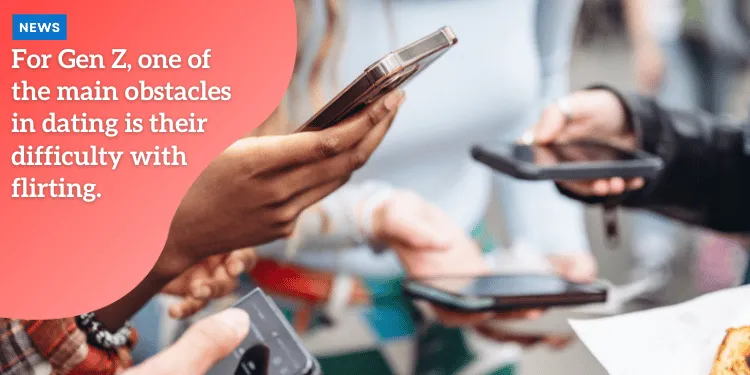For Gen Z, one of the main obstacles in dating is their difficulty with flirting.

Navigating the Intricate Landscape of Modern Romance
Navigating the intricate landscape of modern romance has become increasingly challenging for Generation Z, those born between 1997 and 2012.
Anúncios
Over the past few years, there has been a noticeable shift in how people form romantic connections.
For Gen Z, this shift has introduced both opportunities and significant obstacles.
One of the primary hurdles they face is difficulty with flirting, a skill that many of them have yet to fully master.
Anúncios
In a time when digital communication and social media dominate interpersonal interactions, flirting—the subtle art of expressing romantic interest—has become a skill that is harder to grasp.
The rise of online platforms and dating apps has changed how people approach romance, and for Gen Z, these changes have made it difficult to initiate romantic interactions.
The Struggles of Flirting: A Lost Art
This issue has been highlighted by numerous Zoomers who have shared their struggles with initiating romantic connections.
Anúncios
Many members of this generation have expressed their discomfort or inability to flirt, making it hard for them to establish meaningful relationships.
The combination of a reluctance to flirt and rising social anxiety has made it even more challenging to make authentic connections with others in person.
While some still prefer traditional, face-to-face interactions, this approach does not come without its own set of challenges.
One major reason for these struggles is the lack of familiarity with the social cues and tools required to flirt successfully in the real world.
As society has shifted from in-person communication to digital platforms, the nuances of flirting in a traditional setting have become less understood by many.
A Preference for Offline Dating: The Real-World Challenge
One individual who has reflected on this issue is Nikki Sanjongco, a 24-year-old who, unlike many of her peers, is not fond of dating apps.
She prefers to meet people face-to-face in more organic and traditional settings, despite the challenges that come with this approach.
For Sanjongco and others like her, the art of flirting has become increasingly difficult to navigate.
With more young people expressing a preference for offline dating—forming real-world connections instead of swiping through profiles online—it has become clear that many are not equipped with the necessary social tools to succeed in these face-to-face encounters.
The uncertainty and anxiety surrounding these interactions make it difficult for Gen Z to confidently approach others in social settings.
The Decline of In-Person Interactions and Its Impact on Romance
Recent research has shown that many members of Gen Z struggle with social anxiety, which often prevents them from approaching strangers or initiating romantic conversations.
This trend has been exacerbated by the widespread use of online dating apps, which offer a level of anonymity and comfort that in-person interactions cannot.
As a result, many young people have grown accustomed to digital interactions, leading to a sense of fatigue and disconnection from the superficial nature of online romance.
Over time, the reliance on dating apps has left many feeling disconnected from genuine, real-world interactions.
However, this growing fatigue has also sparked a shift toward offline interactions—more young people are seeking to engage with others face-to-face, but the transition is not always smooth.
A Love-Hate Relationship with Dating Apps
Benjamin Camras, a well-known “flirt coach” with a significant following on Instagram, has observed a “love-hate relationship” between Gen Z and dating apps.
According to Camras, these platforms often foster shallow connections that are more about boosting egos than about creating meaningful relationships.
The online personas that people present on these apps can lead to misunderstandings and miscommunications when trying to build real-world relationships.
Camras believes that the curated images and personas on dating apps are contributing to a sense of disconnection.
Instead of focusing on developing genuine romantic connections, many young people are more concerned with presenting an idealized version of themselves for validation.
This shift toward self-presentation has impacted how Gen Z approaches dating, leaving them uncertain of how to flirt or express romantic interest in person.
Superficial Connections and Their Real-World Impact
This focus on self-presentation and validation can have serious consequences when it comes to flirting and romantic relationships.
As Camras has pointed out, the desire for external validation through likes, matches, and messages has shifted the dynamics of dating.
Many members of Gen Z are overthinking their actions, worried about how they are perceived rather than being present in the moment.
This leads to a lack of authenticity in their interactions.
In a face-to-face conversation, young people often become self-conscious, trying to replicate the validation they receive online, which can make it difficult to form genuine connections.
The shift in focus from authentic connections to seeking external validation creates an environment where flirting becomes more about checking boxes than fostering real emotional connections.
Real-Life Example: A Missed Opportunity
An example of the struggle to read romantic signals without the convenience of dating apps comes from Nikki Sanjongco’s own experience.
She shared an anecdote about a recent interaction in her friend’s apartment complex in Los Angeles.
Sanjongco had a brief conversation with a tall, single man who expressed interest in her.
However, she only learned of his attraction later, through a mutual friend.
This incident underscores a significant challenge in the modern dating landscape: how can someone know if the other person is romantically interested without the clear signals provided by dating apps? In an age where most interactions are digital, the uncertainty of not knowing if someone is interested can be frustrating, and it can lead to missed opportunities for connection.
The Pandemic’s Role in Shaping Social Skills
One of the major contributing factors to Gen Z’s struggles with flirting is the COVID-19 pandemic.
The lockdowns and social distancing measures meant that many people started college or entered the workforce without the usual opportunities to engage in social activities.
As a result, many members of Gen Z missed out on important experiences that would have helped them develop essential social skills, including how to flirt.
The pandemic accelerated the reliance on online communication, further distancing young people from face-to-face interactions.
For many, the shift to virtual communication provided a level of anonymity that was both comforting and distancing, especially when it came to dating.
The “Fear of Being Perceived”
Social psychologist Dr.
Emily Williams has discussed how this reliance on digital platforms has led to a “fear of being perceived.”
Young people today are more worried about how others perceive them, especially in social situations, which makes them hesitant to put themselves out there.
The ease of being ghosted or left on read online gives a degree of separation from the sting of rejection, which is much more immediate and raw in real-life interactions.
For Gen Z, this fear of judgment and rejection has led to an increase in social anxiety, making it difficult to take the risks necessary to engage in romantic or even casual interactions in person.
A Shift Towards In-Person Events: A Glimmer of Hope
Despite these challenges, there is a glimmer of optimism.
In recent months, more young people have been stepping outside their comfort zones and participating in real-life interactions.
Platforms like Eventbrite, which facilitate ticketing for live experiences, have reported a significant increase in searches for in-person events.
In fact, there were 1.5 million more searches for these types of events over the past year.
This increase signals a growing willingness among Gen Z to explore offline social opportunities and move away from the confines of digital connections.
At the events hosted by Dr. Williams, she has noticed a positive trend—more attendees are showing up alone, suggesting a growing confidence in navigating social situations without relying on the safety net of friends or online validation.
Reclaiming the Art of Flirting: A Path Forward
While Gen Z faces significant challenges in the realm of dating, particularly in terms of flirting, there are signs of progress.
The transition from online to offline interactions is not without its difficulties, but with time and practice, many young people are beginning to engage in these real-world encounters with more confidence.
The growing interest in in-person events and the gradual decline of social anxiety surrounding flirting offer hope for a future where Gen Z can confidently navigate the complexities of romance in the real world.
With each step taken outside their comfort zone, young people are slowly reclaiming the ability to flirt, connect, and form genuine romantic bonds in an increasingly digital world.
Conclusion: Overcoming the Flirting Hurdle
In conclusion, while Generation Z faces considerable challenges in the realm of dating—particularly with flirting—there is hope.
The shift from online to offline interactions, while not seamless, is well underway. Gen Z is beginning to rediscover the art of face-to-face flirting and, with time and practice, will likely regain the social skills necessary to navigate modern romance successfully.
As anxiety surrounding in-person interactions lessens and the desire for meaningful connections grows, it seems that Generation Z will, in time, master the delicate art of romance in the real world.
The future of dating may be brighter than expected for the generation that has experienced the greatest digital revolution in human history.





